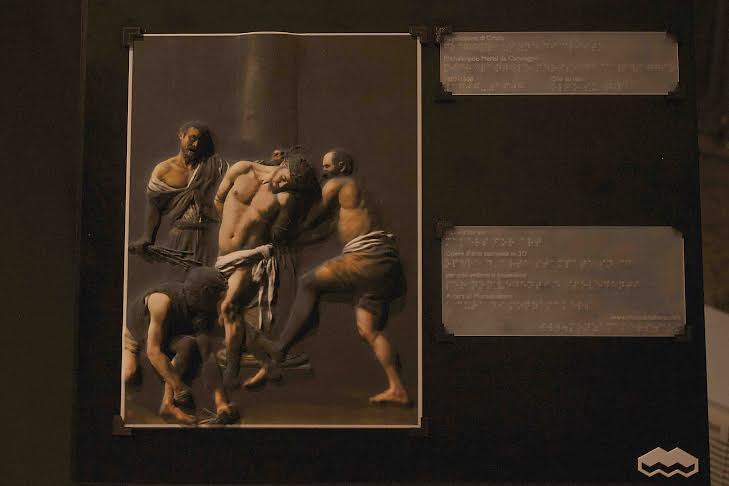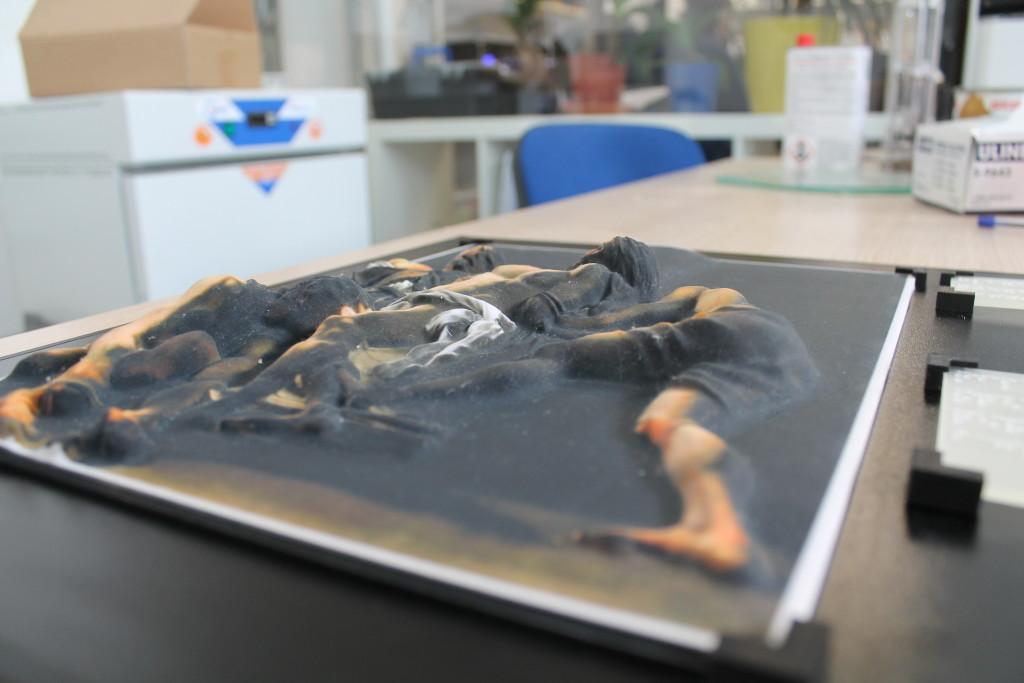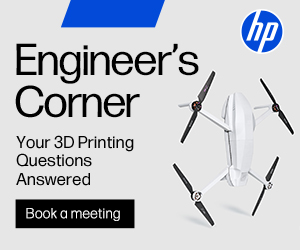Include, Not Exclude: Italian Designers Allow the Blind to Appreciate Caravaggio Through 3D Printing
 Caravaggio was a painter born in Milan in the late 1500s who evolved to be known as one of the most famous painters, well-known for his use of shadows and darkness to contrast subjects held in the light. At one time known as ‘the most famous painter in Rome,’ when not using his considerable talent with the brush, he was engaging in his other passion: fighting. The painter died under mysterious circumstances in 1610, leaving behind a body of work inspiring the Baroque, as well as offering what many also view as the beginning of modern painting.
Caravaggio was a painter born in Milan in the late 1500s who evolved to be known as one of the most famous painters, well-known for his use of shadows and darkness to contrast subjects held in the light. At one time known as ‘the most famous painter in Rome,’ when not using his considerable talent with the brush, he was engaging in his other passion: fighting. The painter died under mysterious circumstances in 1610, leaving behind a body of work inspiring the Baroque, as well as offering what many also view as the beginning of modern painting.
He continues to be celebrated, and most art students will remember him for his intense use of lighting. Recently, Caravaggio’s work was the subject of another project, as MonzaMakers continued in their mission to see that the blind are able to enjoy artwork also through MakersForArt.
We recently became aware of the project through Fabrizio Scalco of MonzaMakers who told 3DPrint.com that they are offering a new way to make art for blind people through 3D printing. As Caravaggio’s Flagellation of Christ was exhibited at their Royal Villa of Monza in what Scalco refers to as an exceptional hosting, he describes their latest work as well:
“…we have 3D printed a 3D tactile version for blind and partially sighted people,” he told 3DPrint.com. “Now our 3D printed Flagellation is exhibited in front of [the] original masterpiece.”
After careful study and modeling by hand, the team was able to take the work of a master and translate it into another pleasing form so that the blind could in essence also experience the artwork comprehensively, amazingly using only the sense of touch. With the 3D printed version, they were meant to feel every detail of the painting—even the dramatic shadows for which Caravaggio is famous.
“Regarding the details in the shadows, these are deliberately less marked to convey to the blind person the same sensations felt by a sighted person, whose eyes, in the absence of light, see less-defined shapes,” state the MonzaMakers team on their website. “In the same way, the surfaces of the areas of the painting that are invested with light are perceived as clear and distinct to the touch.”
The team employed 3D Systems’ ColorJet technology which allowed them to mold objects out of colored gypsum powder. We’ve covered this powerful technology numerous times previously from 3D printing of gaming figurines on demand to making with chocolate to reporting on important companies within the industry relying on 3D Systems innovation for color printing. Now, ColorJet technology is being used for not just an incredible new project, but an incredible cause as well.
The MonzaMakers team sees this new type of technology coupled with the exhibition as the modern opening of a positive Pandora’s box:
“…what comes out of the box is not evil spirits, rather, [but] are the virtues of culture and knowledge, now more accessible than ever to everyone.”
In his use of lighting with such dramatic effect, and especially the use of lantern illumination, the designers found Caravaggio’s work uncannily effective for use with 3D printing, almost as if it were made for such a translation. It’s stressed that in placing a lantern next to his model to create ‘raking light’ and make for a better effect, Caravaggio was indeed giving a 3D element to the subjects he was painting. This was part of what gave the illusion of characters and items ‘coming out’ of a scene, and as the designers envisioned, in their work, features really do come out! And as the designers themselves ask, indeed, ‘how could the Flagellation of Christ be more real, if not by turning it into a 3D printed painting?!’
“Even Merisi’s choice not to fill shadow areas with too many details, but to actually leave them empty, when transposed into 3D, offers the visually impaired the opportunity not only to appreciate a painting overcoming the ‘limit’ of eyesight, but also to stand on an equal footing with the sighted, who perceive less details in the darkness than if they were under a source of light,” state the designers.
“So, in this respect, this 3D version of Caravaggio’s Flagellation of Christ is extremely coherent. The column to which Christ is tied can hardly be seen in the painting and therefore it will only be barely perceivable to the touch in its 3D version.”
 Many details such as Christ’s right leg and its position will be very well understood from the visually impaired perspective, along with the figure in the forefront. With their use of tactile art and 3D printing, the ‘viewer’ can tell that the figure in front is ‘more into relief’ when compared with Christ, as only its most basic shape and volume can be discerned, but really no details.
Many details such as Christ’s right leg and its position will be very well understood from the visually impaired perspective, along with the figure in the forefront. With their use of tactile art and 3D printing, the ‘viewer’ can tell that the figure in front is ‘more into relief’ when compared with Christ, as only its most basic shape and volume can be discerned, but really no details.
It’s obvious that the resulting work was extremely rewarding for the designers, who in no way are ambitious enough to compare themselves to the master, Caravaggio. They did, however, point out that the project was more difficult than one may realize upon an initial glance.
They began with a high-resolution image of Caravaggio’s masterpiece and then studied at length how to proceed from there with a true 3D translation—not a distortion.
“The 2D image was then used as the reference point to shape to the smallest detail the depth areas created at a later stage in the 3D version of the Flagellation of Christ,” said the designers. “In order to achieve this and have the right areas with the right amount of protrusion, we started from principles, i.e. the contrasts in light of Caravaggio’s work; it is the lights and shadows that define the depth, in addition, of course, to the painstaking work of the modeler, who created volumes by hand, using some sort of virtual brush on a graphic tablet.”
Once the group had their hands on a 3D file reproducing the painting, they applied the painting scan.
“Think of a bas-relief carved on a wall and a projector that casts on it an image that fits the protrusions,” said the designers. “The mechanism is the same–the high-resolution image of the painting was applied to the 3D model.”
To make their own work in 3D, that step was necessary so that the designers could proceed with ColorJet printing technology. Why use color? Obviously it was not for the blind, but meant to add visual appeal for the sighted who were also able to enjoy the 3D work greatly.
In post-production, the painting was polished very delicately and with great precision.
“A precise touch is crucial, because the risk of compromising the final product is real,” said the designers.
While the 3D painting itself is an exceptional undertaking and effort, what is even more significant are the lengths that this group of designers went to so that the blind could enjoy one of the greatest painters in history as much as you and I are able to. As the MonzaMakers said so beautifully:
“Such a noble form of expression cannot and must not be a product only for the few. It must include, not exclude.”
What are your thoughts on this type of reproduction? Discuss in the 3D Printed Caravaggio forum over at 3DPB.com.
Subscribe to Our Email Newsletter
Stay up-to-date on all the latest news from the 3D printing industry and receive information and offers from third party vendors.
Print Services
Upload your 3D Models and get them printed quickly and efficiently.
You May Also Like
3D Printing News Briefs, May 3, 2025: Executives, Awards, & a 3D Printing Factory
We’re focusing on additive manufacturing business news today, as both Velo3D and PostProcess Technologies announced changes to their Boards of Directors. Sandvik Metal Powder has a new president, and Klas...
EOS Releases Medical Device Master File for M290 3D Printer
Laser powder bed fusion (LPBF) firm EOS has released a Medical Device Master File that will make it easier for customers to achieve regulatory success. The file will essentially be...
Velo3D Secures $22M Metal 3D Printing Powder Supply Deal with Amaero
Velo3D (OTCMKTS: VLDX) has signed a major new agreement with metal 3D printing powder manufacturer Amaero (ASX: 3DA). The five-year deal is valued at USD $22 million and centers around...
Push Button Metal 3D Printing for $50,000?
In 2021 we wrote an article about “Push Button Metal, the low cost metal 3D printing evolution we are not talking about.” In it, we talked about One Click Metal,...






























